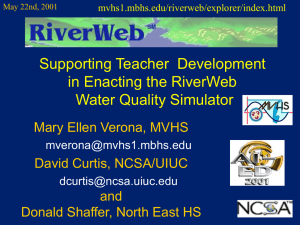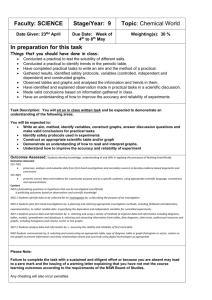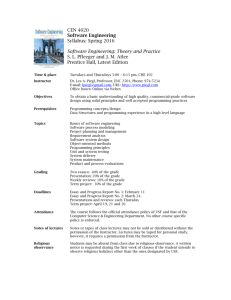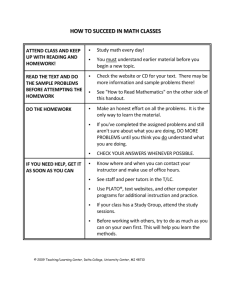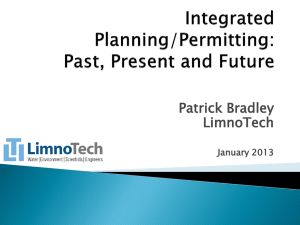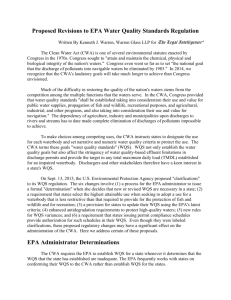maa_march27
advertisement
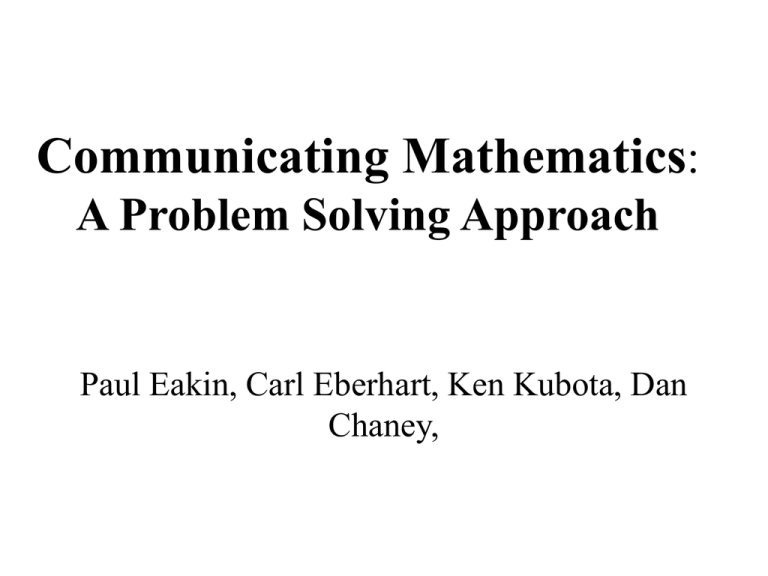
Communicating Mathematics: A Problem Solving Approach Paul Eakin, Carl Eberhart, Ken Kubota, Dan Chaney, General Program • R&D on effective application of communications technology to the teaching of mathematics – software, methodology, materials • Associated Dissemination Project – Course (with text) – Workshops • Support System for teachers • Very much a work in progress General Goals • Improved Preparation of Pre Service Math Teachers • Improved communication/collaboration within mathematics community • Effective Application of technology to teaching of mathematics at all levels Current Approach to Advancing these Objectives is through the application of Technology To Save Teacher Time •Automation of tedious tasks •Collaboration on materials development •Sharing resources •Facilitating parental/community involvement with students Concentration is on general tools • For active use by teacher rather than student • Have modest computing resource requirements • Are intended for remote and out-of-class use – No infringement on traditional class time • Require minimal computer skills – Trade off with very solid knowledge of mathematics • Support collaboration across large communities • Not dependent on local school computer systems The most obvious (to us) source of time saving is in the management of homework • Assignment • Checking* – Feedback • Logistics – Collection – Return – Record Keeping The Tools: Part 1 (WQS) • Used for two years in basic calculus and linear algebra • Handles: • • • • • • formatted Mathematics Chat groups Student-teacher email Visual rolls Video lectures Sharing of problem sets • Has primitive data handling • Multiple choice format • Too much data Primary Student Interface: Instructor’s Web Page • • • • syllabus links to html text links to chat system and FAQ systems links to “WQS” system for course materials (e.g. homework, review materials, video lectures, etc) Student Interface: Instructor’s Web Page (part 1) System tutorial Course syllabus Visual class rolls Exam schedule Class Roll: Instructor’s Web Page (part 2) Link to wqs system server Student emails from homework system with responses Links to lecture notes for video lectures Responses to Student Questions: Page references particular assignment Student query Instructor response Instructor Web Page (part 3) Link to wqs system Link to online text Links to lecture slides for video lectures by chapter WQS System: login screen Students select video lectures menu or their class homework menu Group logins and work are encouraged Typical Section Menu Chapter 1 homework Review for test II Homework Page: Basic Format System response Student answer System answer Problem and answers Email window Most students print the problem sets out and record their solutions or solutions from class directly on the printouts Video Lectures Menu Lecture Slides (html) Video of lecture segment (10-30 min) How students watch the videos Test Review with video solutions: Model for current experiments Problem statement with diagram Link to video solution Data Logs • Every student action is logged with time stamp • All activity credited to each member on group login • Total number of answers submitted (right or wrong) correlates very well with performance on tests Log Data Preparing Materials CD burner and blanks food coffee Remark on WQS CDs • Natural corollary of HTML format – easily made at faculty desk, cheap – Students copy in lab on their own blank (15 min, $1) • Originated through necessity (bandwidth, reliability) • Strongly favored by upper-level students who tend to live off-campus • Not used much by lower level students who tend to live on campus Maple Source: WQS Homework Problem Question Tag:( Q_ ) “SKIP” Tags Code for Figure (section) Answer Tags: ( A_ ) Correct Answer Tag SAMPLE WQS TAGS • • • • • Q_ Question starts and runs to next tag T_ Text starts and runs to next tag A_ Answer choice for current question A_ANS Correct answer for current question SKIP Omit from here to next tag To create and “post” a simple wqs homework set: • Source document is exported to html from Maple menu • exported html document is processed by a Perl script to: – create a “data” file which describes the final document to the server – place an entry in a control file which describes the menu Control File is basis for sharing Sharing Materials: Ken made homework set number 8 Paul made homework set number 7 This is Paul’s Control file LOAD SHARING Student login 1 To B’s class 5 B’s Files ma123 control homework 3 5 2 4 materials wqs Wqs system 2 Student login To A’s class lecture 3 B’s Files wqs ma123 control 1 Sharing: Laura’s Ma123 Control File and class menu Sharing: Laura and Jody Do Ma123 Lectures Sharing: Control File for Joe Mahoney’s Paducah, KY Section of Ma322 Carl Eberhart created the homework for the Ma322 sections Joe Mahoney and Avinash Sathaye did Videos for MA322 Unified Format: Video link LaTeX math formatting Web homework is part of text in unified format Experience with WQS: It does work. But … • Works much better with motivated, advanced students • Primary problem is compliance • Problem with misinformed faculty, advisors Student response to Ma123 as reported in the student paper Tools: Part 2 (MathClass) • • • • Currently under development Subsumes WQS Very general format Promotes sharing/collaboration across net: – development – individual problems • Better data management MathClass Visuals: MathClass does homework grading in advance – “frontloads” Format: Print out problems – work them away from computer – Perhaps use computer to work problem MathClass Dissemination • • • • • Software is freely distributed (except Maple) UK will provide service of problems 2-day workshop on setup 1-day workshop to use “shopping basket” 3-day workshop for experienced teacher familiar with Maple • 2-week workshop for experienced teacher not familiar with Maple • One semester course for pre-service teacher Course needs to provide • • • • Serious introduction to Maple Comprehensive overview of system structure Facility with tools Experience – Use of the system – Collaborative materials development Philosophical Difficulties: Formally not a Math Class • Looks on its face like an elementary computer skills course • What is the intellectual content? • Where does it fit in a crowded curriculum? Observations • WQS materials move readily to MathClass (something is conserved) • Effort is mathematical problem-solving at a nontrivial level – – – – Creating diagrams, answers (WQS) Creating solver (MathClass) Verification Requires wide variety of math tools even for elementary problems • MathClass environment permits development of non-traditional types of problems . Conclusion • The material fits nicely into a mathematical communications/problem solving course • Basic Activities are creation, presentation and solution of problems – Diagrams, – Checkers, • Substitutes for conventional problem solving course • Provides communications skills • Excellent introduction to instructional technology Ma375: Communicating Mathematics • • • • Course description Walkthrough Math prerequisites Communication – Written, oral, collaboration, continuation, community building Layout of Ma375 • • • • • • • • Text/software required Topics Operation Testing Connection with student teaching NSF support – Looking for collaborators/testers Services Layout continued • • • • • • Security Intellectual property considerations Design of modules as executables NSF requirements Workshops Materials Math 375 (General Outline) • Using MathClass (2 wks) • Using Maple to Create Problems (6 wks) – Basic techniques – Graphics techniques – Solvers • Additional topics and techniques (2 wks) – Security, intellectual property, – Video, and other advanced techniques • Materials development lab (6 wks) 1. Hand sketch 3. Assign values to variables 4. Realize image 2. Abstract Object in Maple 1. Add property (e.g. color) 2. Explore simple extensions 3. Have students extend it further. Making Compound Objects Exercise: Remake the “K” Cube with a properly Formatted “K” Animation Basic Drawing/Annotation: • • • • DL ( “Draw Line”) PT (“Put Text”) PP (“Put Point”) GP (“Graph Paper”) • PA (“Put Arc”) • ARRW (“Dbl or Sngl Arrow”) Workshop: Live development of a problem set • Make video prompt(s) Lab Activities: • • • • • • Making CD/DVD Operating personal site Evaluation Collaboration Making/integrating video JAVA and other tools
